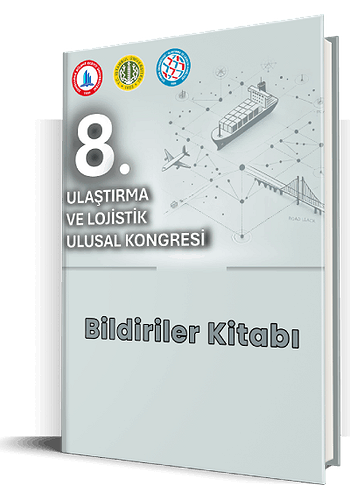
Ulaştırma ve Lojistik Kongreleri
- Türkçe
- Özet
- 2024
Buharın Gücünden Veri Çağına: Ulaşımın Toplumla Örülen Hikâyesi
Gülten Akgül
T.C. Milli Eğitim Bakanlığı, , Türkiye
Sanayi Devrimi, 18. yüzyılın sonları ve 19. yüzyılın başlarında İngiltere’de ortaya çıkan, üretim süreçlerini köklü bir şekilde dönüştüren bir dönüm noktasıdır. Bu devrim, üretim kapasitesini artırarak ve yeni teknolojiler geliştirerek sadece ekonomik yapıyı değil, aynı zamanda toplumsal, kültürel ve coğrafi yapıları da derinden etkilemiştir. Bu dönemde, ulaşım ve lojistik alanlarında meydana gelen devrimsel yenilikler, ticaretin küreselleşmesi, mal taşımacılığının hızlanması ve sanayileşmiş toplumların dinamiklerinin değişmesiyle birlikte tarih sahnesinde önemli bir yer tutar. Özellikle demiryollarının, buharla çalışan gemilerin ve ilk motorlu taşıma araçlarının icadı, taşımacılığın verimliliğini artırmış ve sanayinin gelişmesine paralel olarak lojistik sektörünü de dönüştürmüştür. Sanayi Devrimi’nin bu lojistik yeniliklerle birleşmesi, zaman içinde taşımacılığın küresel boyutta hızlanmasını ve ürünlerin daha geniş bir pazara ulaşmasını ve ekonomi anlayışlarını da şekillendirmiştir. Sanayi Devrimi, sadece teknolojik yenilikler getirmekle kalmamış, aynı zamanda insanların yaşam biçimlerini, iş gücünü ve şehirleşme süreçlerini de derinden etkilemiştir. İngiltere’nin merkez olduğu bu dönüşüm, özellikle ulaşım altyapısındaki devrimci gelişmelerle doğrudan ilişkilidir. Sanayi Devrimi’nin lojistik alanındaki yenilikleri, yalnızca tarihsel bir olgu olarak değil, aynı zamanda modern lojistik ve ulaşım sistemlerinin temellerini atan önemli bir gelişim süreci olarak değerlendirilmelidir. Bu süreçte, demiryolları, buharla çalışan gemiler ve motorlu taşıma araçları, mal taşımacılığının hızını artırarak, üretim ve tüketim ilişkilerini yeniden tanımlamıştır. Bu yenilikler, sadece ulaşım altyapısını değil, aynı zamanda ekonomik yapıların küreselleşmesini de hızlandırmıştır. Dijitalleşen günümüz dünyasında ise lojistik sektörü, teknolojik gelişmelerle benzer bir evrim geçirmektedir. Lojistikteki bu iki dönemin paralellikleri, geçmişin derslerinden faydalanarak günümüz sistemlerinin daha verimli hale gelmesine olanak tanıyabilir. Bu bağlamda, bu çalışmanın amacı, Sanayi Devrimi’nin lojistik ve ulaşım sistemleri üzerindeki etkilerini analiz ederek, bu tarihsel dönüşüm ile günümüzdeki dijitalleşme süreçleri arasındaki benzerlikleri ortaya koymaktır. Bu çalışmada tarihsel analiz, nitel araştırma ve karşılaştırmalı yöntemler kullanılmıştır. Sanayi Devrimi dönemindeki ulaşım ve lojistik sistemleri, dönemin edebi eserleriyle birlikte ele alınmış, ayrıca günümüz dijitalleşmiş lojistik sistemleri ile karşılaştırmalar yapılmıştır. İngiliz yazar ve toplum eleştirmeni Charles Dickens’ın (1812-1870) romanları toplumsal yapıyı ve teknolojik yeniliklerin insan hayatına etkilerini dolaylı olarak yansıtan eserlerdir. Bu tür kaynaklar, dönemin lojistik ve ulaşım sistemlerine dair önemli ipuçları verebilir. Ayrıca, dönemin tarihsel belgeleri ve literatür taraması kullanılarak lojistik sistemlerin evrimi hakkında derinlemesine bilgiler edinilmiştir. Elde edilen bulgulara göre Sanayi Devrimi sırasında, en büyük etki taşımacılık ve lojistik alanında görülmektedir. Demiryollarının inşası, özellikle İngiltere’de, kara taşımacılığını devrim niteliğinde değiştirmiştir. Demiryolları, büyük miktarda mal ve hammaddeyi hızlı ve maliyet etkin bir şekilde taşıma imkânı tanımış, aynı zamanda iş gücünün ve hammaddelerin daha verimli bir şekilde taşınmasını sağlamıştır. Bunun yanı sıra, buharla çalışan gemiler, deniz taşımacılığını hızlandırarak küresel ticaretin gelişmesine olanak tanımıştır. Bu yenilikler, ürünlerin daha uzak bölgelere daha hızlı ulaşmasını sağlayarak, sanayi üretiminin küresel pazarlarda entegrasyonunu hızlandırmıştır. Bu dönemdeki diğer önemli yenilik ise ilk motorlu taşıma araçlarının icadıydı. Motorlu taşıma araçları, özellikle şehir içi taşımacılığı ve küçük ölçekli dağıtımı hızlandırmış, lojistiğin daha da etkin hale gelmesini sağlamıştır. Tüm bu gelişmeler, lojistiğin daha verimli hale gelmesini sağlayarak, Sanayi Devrimi’nin üretim ve ticaret üzerine olan etkilerini pekiştirmiştir. Sanayi Devrimi’nin lojistik ve ulaşım sistemleri üzerindeki etkileri sadece ekonomik anlamda değil, toplumsal yapılar üzerinde de büyük bir değişim yaratmıştır. Charles Dickens gibi yazarlar, sanayileşmenin getirdiği toplumsal eşitsizlikler, işçi hakları ve sınıf farkları gibi konuları eserlerinde işleyerek, bu yeniliklerin insanlar üzerindeki derin etkilerine dikkat çekmiştir. Edebiyat, dönemin ulaşım ve lojistik altyapılarına dair ipuçları verirken, aynı zamanda bu teknolojilerin getirdiği toplumsal değişimleri de gözler önüne sermiştir. Sanayi Devrimi’ndeki ulaşım yeniliklerinin dijitalleşen lojistik sistemlerine benzerliği, günümüzde daha verimli taşımacılık ve lojistik ağlarının kurulmasına olanak sağlamaktadır. Günümüz dijitalleşmiş lojistik sistemleri, büyük veri, yapay zekâ, robotik sistemler gibi teknolojilerle, tıpkı demiryolları, buharla çalışan gemiler ve motorlu araçların devrimsel etkileri gibi taşımacılığı daha verimli hale getirmektedir. Gelecekteki lojistik süreçlerinin daha hızlı, daha az maliyetli ve çevre dostu olması adına, Sanayi Devrimi’nin yenilikçi bakış açılarından ilham alınabilir. Bu çalışma, lojistik ve ulaşım sistemlerinin tarihsel evrimini anlamak ve günümüz dijitalleşmiş lojistik altyapısının gelişimine katkı sağlamak açısından önemli bir kaynak olabilir. Ayrıca, Sanayi Devrimi’nden günümüze kadar süregelen lojistik yeniliklerin karşılaştırılması, toplumsal ve ekonomik yapılar arasındaki ilişkiyi de açığa çıkarmaktadır. Bu tür araştırmalar, gelecekteki lojistik politikalarının şekillendirilmesine ve ulaşım altyapılarının daha verimli hale getirilmesine ışık tutacaktır.
Anahtar Kelimeler: dijital, Sanayi Devrimi, Lojistik, toplumsal yapı, Ulaşım
From the Steam Power to the Data Age: The Story of Transportation Woven with Society
The Industrial Revolution is a turning point that emerged in England in the late 18th and early 19th centuries and radically transformed production processes. This revolution deeply affected not only the economic structure but also social, cultural, and geographical structures by increasing production capacity and developing new technologies. The revolutionary innovations that occurred in the fields of transportation and logistics during this era have a prominent place in history, along with the globalization of trade, the acceleration of goods transportation, and the change in the dynamics of industrialized societies. In particular, the invention of the railways, steam-powered ships, and the first motorized transportation vehicles increased the efficiency of transportation and transformed the logistics sector in parallel with the development of industry. The combination of the Industrial Revolution with these logistics innovations has, over time, accelerated transportation on a global scale, helped products reach a wider market, and shaped economic understandings. The Industrial Revolution not only brought technological innovations but also deeply affected people’s lifestyles, workforce, and urbanization processes. This transformation, in which England was the center, is directly related to the revolutionary developments, especially in transportation infrastructure. The innovations of the Industrial Revolution in the field of logistics should be evaluated not only as a historical phenomenon but also as a significant development process that laid the foundations of the contemporary logistics and transportation systems. In this process, railways, steam-powered ships, and motorized transport vehicles increased the speed of goods transportation and redefined production and consumption relations. These innovations accelerated not only the transportation infrastructure but also the globalization of economic structures. In today’s digitalizing world, the logistics sector is undergoing a similar evolution with technological developments. The parallels between these two periods in logistics can enable today’s systems to become more efficient by benefiting from the lessons of the past. In this context, the aim of this paper is to analyze the effects of the Industrial Revolution on logistics and transportation systems and to reveal the similarities between this historical transformation and today’s digitalization processes. Historical analysis, qualitative research, and comparative methods were used in this study. Transportation and logistics systems during the Industrial Revolution were discussed together with the literary works of the era, and comparisons were made with today’s digitized logistics systems. The novels of the English writer and social critic, Charles Dickens (1812-1870), are the works that indirectly reflect the social structure and the effects of technological innovations on human life. Such sources can provide significant clues about the logistics and transportation systems of the era. Additionally, in-depth information about the evolution of logistics systems was obtained using the historical documents of the era and literature review. According to the findings, during the Industrial Revolution, the biggest impact was seen in the field of transportation and logistics. The construction of railways, especially in England, revolutionized land transportation. Railways provided the opportunity to transport large amounts of goods and raw materials quickly and cost-effectively and also provided more efficient transportation of labor and raw materials. In addition, steam-powered ships accelerated maritime transportation, allowing the development of global trade. These innovations accelerated the integration of industrial production with global markets by allowing products to reach more distant regions more quickly. Another significant innovation in this era was the invention of the first motorized transport vehicles. Motorized transport vehicles accelerated urban transportation and small-scale distribution in particular and made logistics even more effective. All these developments made logistics more efficient, reinforcing the effects of the Industrial Revolution on production and trade. The effects of the Industrial Revolution on logistics and transportation systems created a major change not only in economic terms but also on social structures. The writers such as Charles Dickens drew attention to the profound effects of these innovations on people by addressing issues such as social inequalities, workers’ rights, and class differences brought about by the industrialization in their works. While literature gave clues about the transportation and logistics infrastructures of the period, it also revealed the social changes brought about by these technologies. The similarity of transportation innovations in the Industrial Revolution to digitalized logistics systems enables the establishment of more efficient transportation and logistics networks today. Today’s digitalized logistics systems are being developed with technologies such as big data, artificial intelligence, and robotic systems, just like railways, steam-powered ships, and it makes transportation more efficient, like the revolutionary effects of the motor vehicles. In order for future logistics processes to be faster, less costly, and more environmentally friendly, inspiration can be drawn from the innovative perspectives of the Industrial Revolution. This study can be a beneficial source for understanding the historical evolution of logistics and transportation systems and contributing to the development of today’s digitized logistics infrastructure. In addition, comparing logistics innovations from the Industrial Revolution to the present also reveals the relationship between social and economic structures. Such studies will shed light on the shaping of future logistics policies and making transportation infrastructures more efficient.
Keywords: Logistics, digital, the Industrial Revolution, Transportation, social structure


Bu çalışma, kullanan kişilere orjinal çalışmadan alıntı yaptıkları sürece, çalışmayı dağıtma, değiştirme ve üzerine çalışma hakkı tanıyan Attribution 4.0 International (CC BY 4.0) lisansı ile lisanslanmıştır.
İletişim
İstanbul Üniversitesi Ulaştırma ve Lojistik Fakültesi
İ.Ü. Avcılar Kampüsü 34320 Avcılar/İstanbul
ulk@istanbul.edu.tr
+ 90 (212) 440 00 00 - 19200


